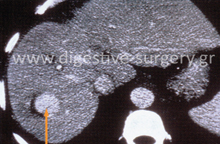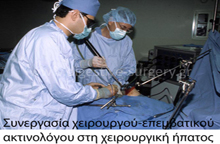Radiofrequency Ablation
Liver cancer may be aggressive. It may be either primary (because of hepatic and cirrhosis), or metastatic (coming from another distant organ). In either form, its prognosis is guarded. There is no question that the treatment offering the best and most chances for cure is surgical resection of the liver cancer (hepatectomy). However, not all patients with liver cancer can be subjected to a hepatectomy. This may be because the cancer is either too extensive (widespread) within the liver and if it was removed there would not be enough normal liver left, or because it arises in many different spots (multifocal), or because the patient has advanced cirrhosis and cannot be safely put to anesthesia and subjected to a big operation. For all these types of patients, who in fact are the majority of patients with liver cancer, chemotherapy has been the only available and possible treatment. Unfortunately, chemotherapy is not usually associated with impressive results in patients with liver cancer.
During the last few years however, there has been a possible solution for some of these patients. It is called Radiofrequency Ablation. It entails the actual destruction (necrosis-“dying off”) of the cancer lesions without surgical removal. The way we achieve this, is by applying a thin metal probe in the center of a cancer lesion under local anesthesia and with the help of ultrasound guidance. This thin metal probe is connected to a device that provides energy, so the final result is the increase of the temperature within the cancer lesion up to 95 degrees Celsius. What this does is the “melting” essentially of the cancer cells, and their death. Radiofrequency ablation is a minimally invasive form of treatment, usually performed without an actual operation. In such a case, where an operation is not required, it can be performed as an outpatient. For the safe and successful implementation of this treatment modality it is essential that there is a team of experts available and present. Our team, consisting of a surgeon, an interventional radiologist and a hepatologist, has performed hundreds of such treatments. In fact our team was the very first to apply this method in Greece during 2001.
Radiofrequency ablation can be utilized as the sole treatment of cancer lesions of the liver in some patients, but it can be also applied as part of the treatment of liver cancer in some patients, or as an intermediate step (“bridge”) to hepatectomy. The exact place and role of this modern modality depends on the overall condition of each patient, the exact type of liver cancer, the precise anatomic distribution of the cancer lesions within the liver, and the experience and level of excellence of the medical team of experts. Generally, radiofrequency ablation should be viewed as one part of a broader strategy with the aim of curing liver cancer, or as one of the treatment modalities available to be utilized in such patients.













